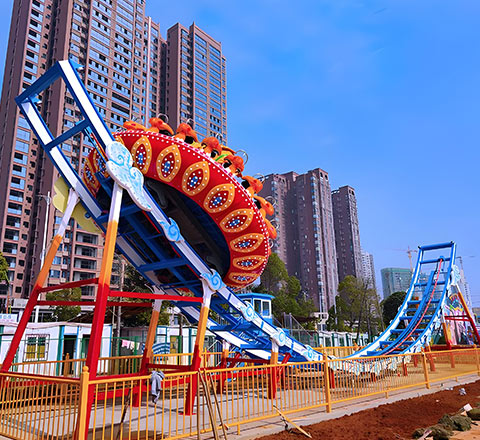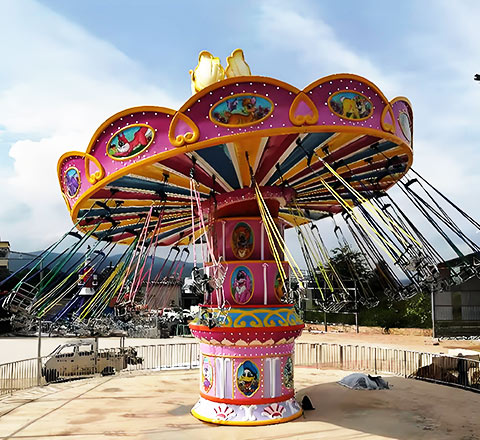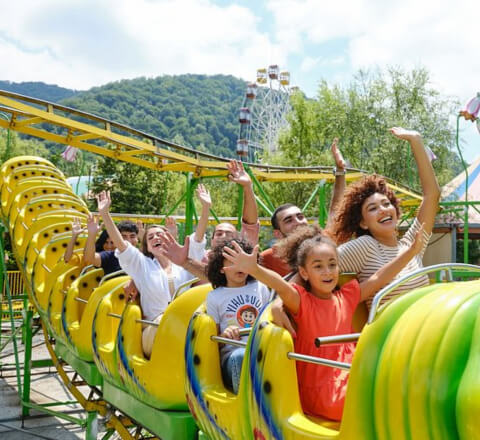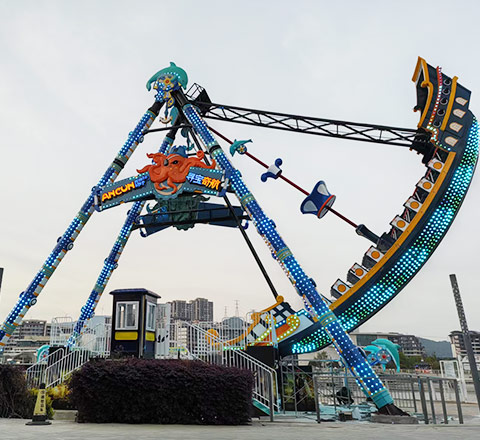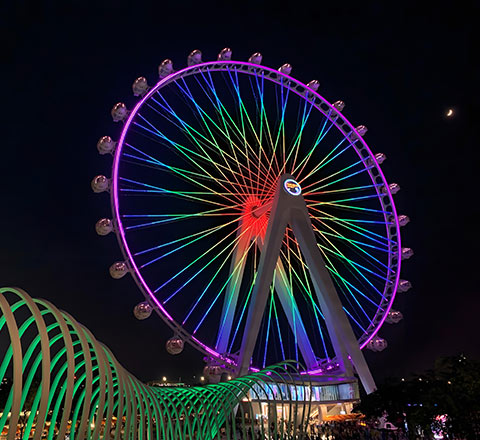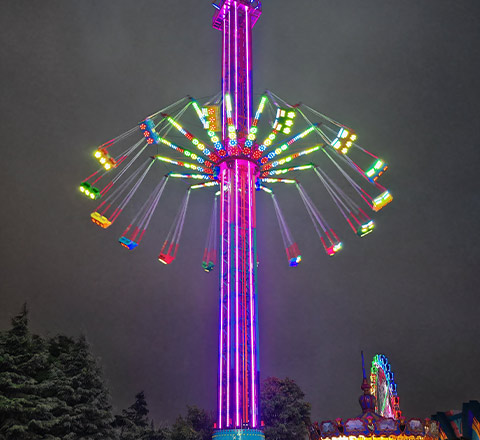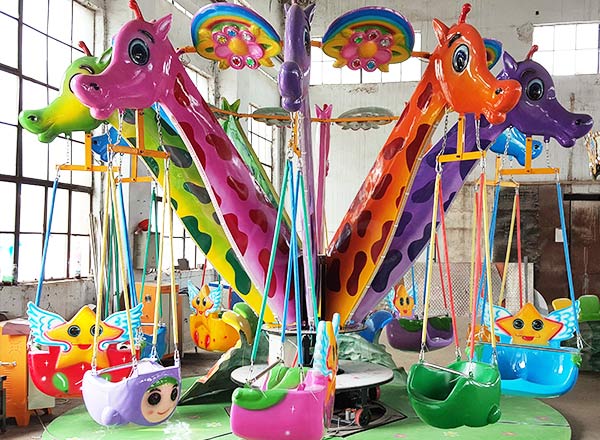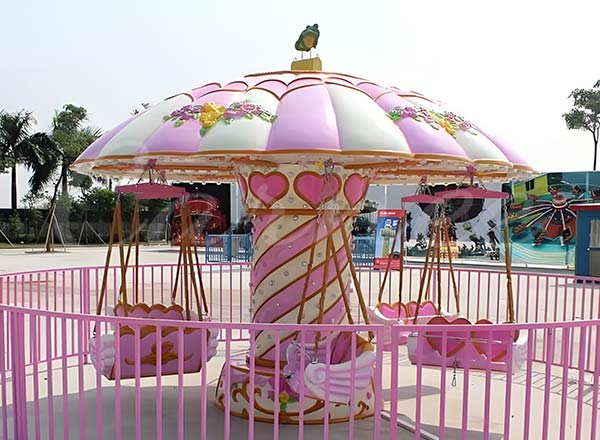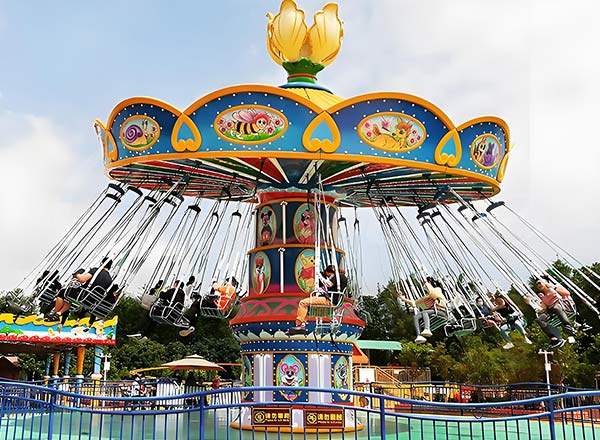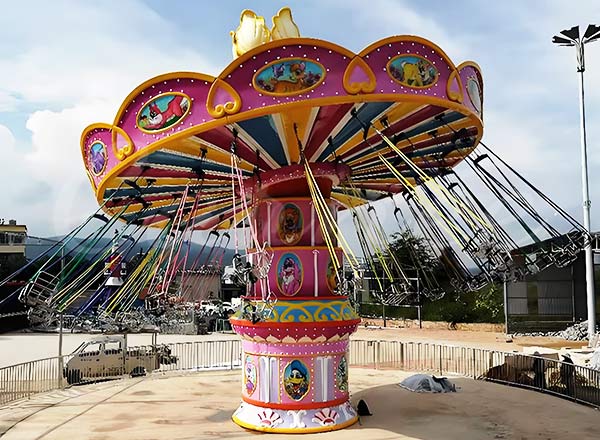Among the many attractions at amusement parks, fairs, and theme parks, few are as iconic and timeless as the Swing Carnival Ride. This classic amusement park swing ride combines the nostalgic charm of a carousel with the thrilling sensation of soaring through the air.
This guide is designed as a comprehensive FAQ for park operators, investors, and enthusiasts. From basic knowledge and mechanical principles to safety standards, pricing, installation, and customization, we cover everything you need to know about this iconic spinning swing carnival ride and its role in modern entertainment venues.
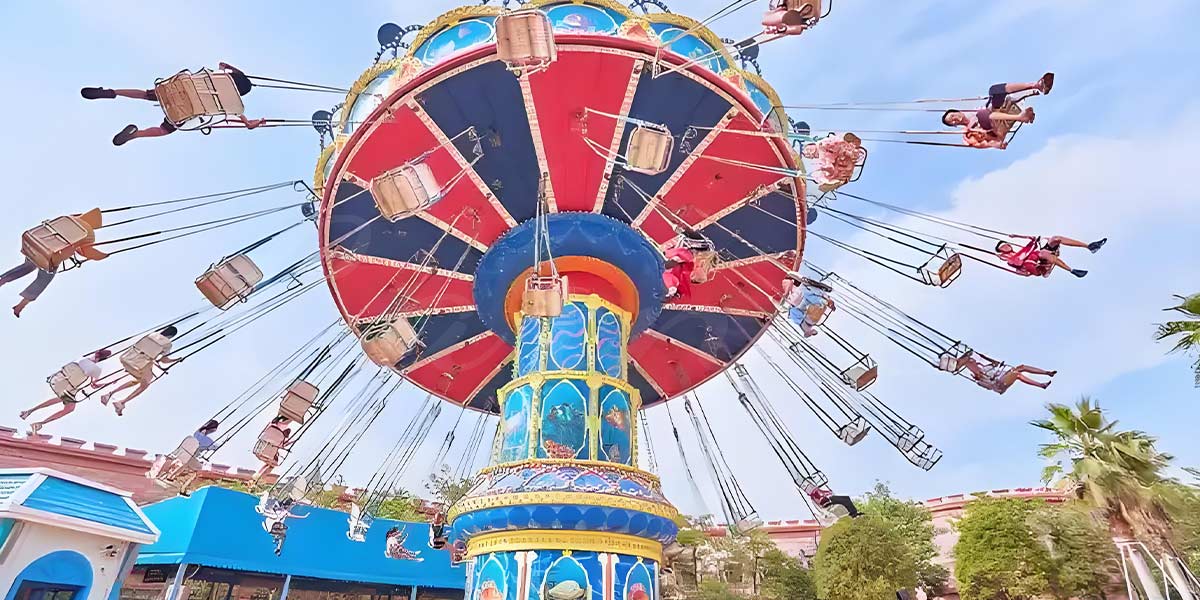
I. Basic Knowledge
What Is a Swing Ride?
A carnival swing ride, commonly referred to as a flying chair ride in China, is a typical amusement park swing ride. The structure consists of a central rotating hub with seats suspended by chains or steel rods. Once the hub begins to rotate, the chairs swing outward, creating a thrilling sensation of flying.
This is why the swinging amusement park ride is often considered both a family-friendly option and a must-have carnival attraction.
Common Names of Swing Rides
Depending on the region and industry terminology, swing rides are also called:
- Flying Swing Ride / Flying Chair Ride
- Swing Carousel Ride / Carousel Swings
- Chair Swing Ride / Swing Chair Ride
- Yo-Yo
- Wave Swinger Ride
- Fairground Swing Ride
- Theme Park Swing Ride
- Chair-o-Planes
- Spinning Chair Ride
Despite the different names, all these terms describe the same type of swing carnival ride.
Historical Origins of Swing Carousel Rides
While many assume the swing ride was inspired by the carousel, the truth is quite the opposite. As early as the Byzantine era, a primitive version of the circular swing ride existed. People tied baskets to ropes fixed on a central pole and rotated around it for fun. Later, in medieval Europe, this form merged with knight training games, eventually evolving into both the carousel and the modern flying swing ride.
In the modern era, swing rides continued to advance. A landmark innovation came in 2011, when Cedar Fair amusement park in the United States introduced the WindSeeker, a towering swing ride that could carry 64 passengers to nearly 100 meters high. It instantly became both a thrill ride and a park landmark, cementing the reputation of tower flying swings worldwide.
👉 Related reading: The Evolution and History of Swing Rides
II. Mechanism & Experience
How Do Swing Rides Work?
The swing ride amusement park model is based on centrifugal and centripetal forces:
- The central motor drives the hub to rotate.
- The suspended seats are pushed outward by centrifugal force.
- Passengers experience the sensation of flight as the chairs swing in a circular motion.
- Some models include lifting or tilting mechanisms for added excitement.
This simple yet effective principle is what makes swing fairground rides so enduringly popular.
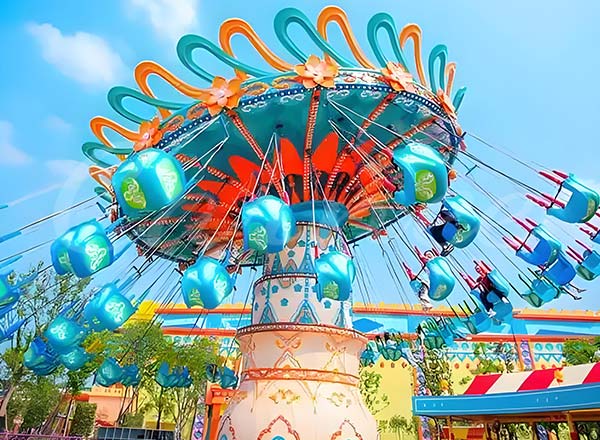
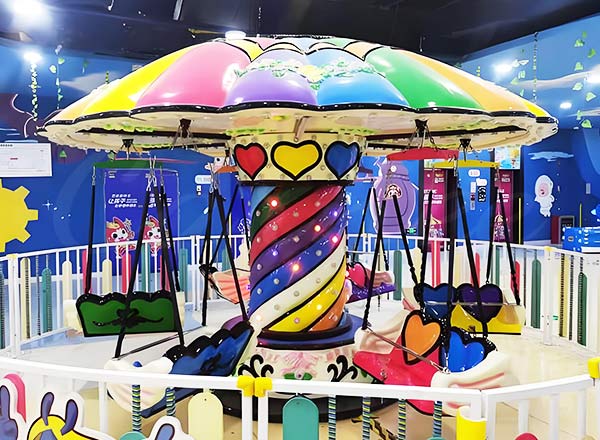
How High Can a Carnival Swing Ride Go?
| Type | Height Range | Typical Application |
| Kiddie Swing Ride | 2–4 m | Shopping malls, small playgrounds |
| Standard Amusement Park Swing Ride | 5–10 m | Amusement parks, carnivals |
| Large Swing Carousel Ride | 10–15 m | Major theme parks |
| Tower Flying Swings | 30–100 m | Landmark attractions, mega parks |
Thus, from gentle kiddie swing rides to massive tower flying swings, the ride offers thrills for all age groups.
What Is the Speed of a Swing Ride?
Most swing rides at amusement parks operate at speeds between 45–65 km/h.
- For children, fairground swings run at lower speeds.
- For adults and thrill-seekers, theme park swing rides operate faster, enhancing the excitement.
Age & Weight Limits
| Type | Age Limit | Weight Range |
| Kids Swing ride | 3–8 years | 15–40 kg |
| Standard Swing Ride | 6+ years | Up to 90 kg |
| Large/Tower Swing Rides | 10+ years | Up to 100–120 kg |
Seating Capacity
| Model | Capacity | Target Audience |
| Small Swing Ride | 6–12 riders | Children |
| Midium Size Swing Ride | 16–24 riders | Children + Adults |
| Giant Swing Ride | 32–48 riders | Families & Teens |
| Swing Tower | 48–64 riders | Adults, thrill-seekers |
This high throughput makes swing rides at fairs and carnivals particularly profitable.
III. Safety & Compliance
What Safety Features Do Swing Rides Have?
Since swing carnival rides operate at significant heights and speeds, safety is the top priority. Common measures include:
- Seat belts and lap bars to secure riders
- Emergency braking and backup power systems
- Reinforced structures to withstand harsh weather
- Professional operator training for safe boarding and operation
International Standards & Certifications
A qualified swing theme park ride should meet global safety standards, such as:
- CE (Europe)
- ASTM (United States)
- ISO9001 Quality Certification
- EN 13814 (Amusement Ride Safety)
- TÜV (Germany)
👉 Related reading: Flying Swing Ride Safety Standards & Certifications
What Happens During a Power Outage?
In case of power failure, modern swinging carnival rides have multiple safeguards:
- The emergency braking system activates, slowing the ride safely.
- Backup generators provide temporary power.
- Operators assist passengers in disembarking.
- Only after inspection and fault resolution is the ride restarted.
IV. Cost & Return on Investment
How Much Does a Swing Carnival Ride Cost?
| Type | Price Range (USD) | Notes |
| Swing Ride for Kids | $15,000 – $30,000 | Small children’s parks, malls |
| Standard Swing Amusement Park Ride | $30,000 – $80,000 | Common in fairs & parks |
| Big Swing Carnival Ride | $80,000 – $150,000 | Core theme park attraction |
| Swing Tower Ride | $150,000+ | Landmark installations |
Installation Costs
A complete setup—including transport, assembly, testing, and staff travel—usually costs $50,000–$150,000 depending on customization and park conditions.
ROI (Return on Investment)
Compared with roller coasters and Ferris wheels, carousel swing rides have lower upfront costs and higher throughput. Most parks achieve payback within 6–18 months, followed by steady profits.
👉 Related reading: Types of Swing Carnival Rides: A Complete Guide for Park Owners
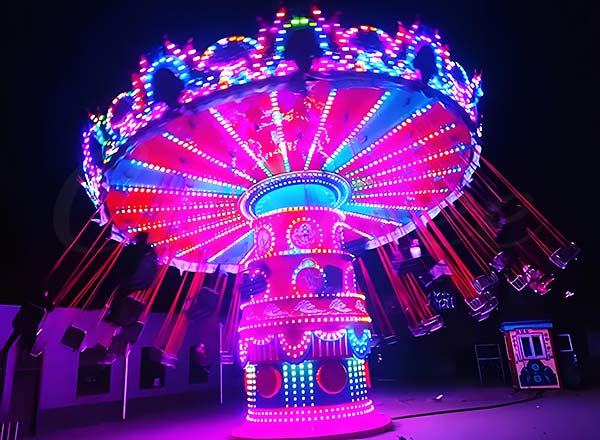
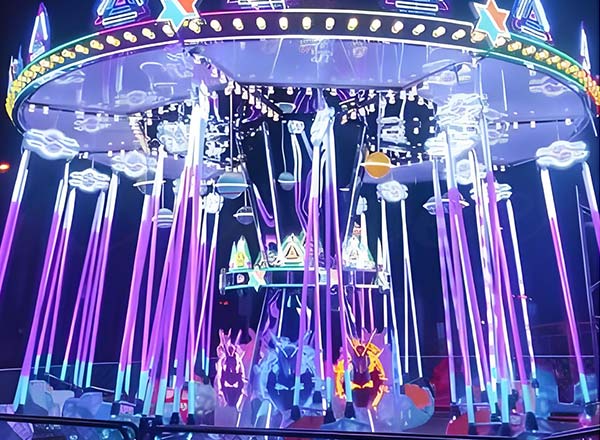
How to Reduce Swing Carnival Ride Maintenance Costs?
- Train in-house staff to reduce outsourcing
- Implement structured inspection schedules
- Use high-quality parts for durability
- Take full advantage of manufacturer warranties
👉 Related reading: Swing Ride Maintenance Guide
V. Installation & Maintenance
Installation Process
Installing a swing fairground ride typically involves:
- Site inspection & groundwork
- Shipping & unpacking equipment
- Structural assembly (hub, frame, chairs)
- Electrical wiring & PLC setup
- Ride testing & calibration
- Safety approval & operator training
The process usually takes 7–15 days; tower models may take longer.
Key Components of a Swing Amusement Ride
- Seats and suspension chains
- Central shaft and motor
- PLC control system
- Lighting and audio equipment
Routine Maintenance of the Spinning Swing Ride
To ensure long-term safety and smooth operation, amusement park ride swings require structured and consistent maintenance. Operators should establish a clear schedule that includes the following steps:
- Daily checks – Inspect critical components such as bolts, suspension chains, and rider safety belts to confirm they are secure and functioning properly.
- Weekly tasks – Apply lubrication to motors, bearings, and other moving parts to minimize friction, reduce wear, and extend equipment lifespan.
- Monthly reviews – Test the control system, including PLC programming and emergency brake functions, to guarantee reliable performance under all conditions.
- Quarterly inspections – Arrange a comprehensive evaluation by certified professionals to identify potential issues, replace worn parts, and verify compliance with international safety standards.
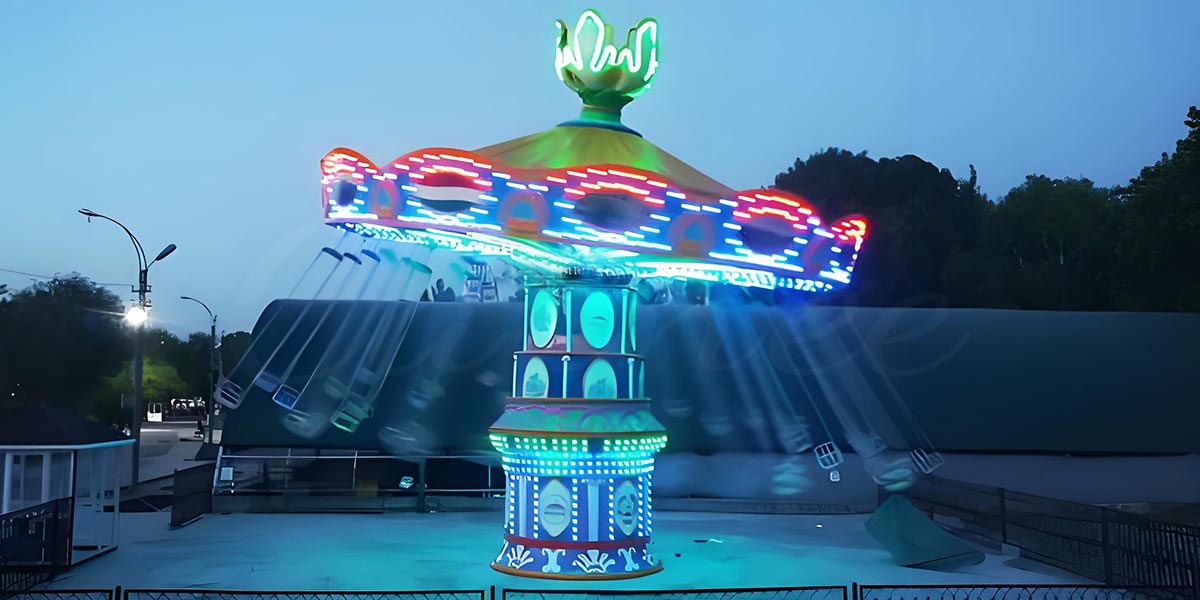
VI. Manufacturers & Import
How to Choose a Reliable Swing Ride Manufacturer?
Selecting the right partner is one of the most critical steps when investing in a spinning swing ride. A reliable manufacturer not only ensures product quality but also provides long-term safety and financial security for park operators. When evaluating potential suppliers, consider the following key factors:
- Proven industry experience – Look for manufacturers with at least 10 years of continuous operation in the amusement ride industry. A long track record reflects both technical maturity and market credibility.
- International certifications – Ensure the company complies with recognized standards such as CE (Europe), ASTM (USA), and ISO. These certifications confirm that the rides meet stringent global requirements for quality and safety.
- Comprehensive service network – A trustworthy manufacturer should provide global installation support, operator training, and responsive after-sales service. This is especially important for parks located far from the factory.
- Transparency and references – Prefer suppliers who can arrange factory visits and share real customer case studies. First-hand inspections and client testimonials provide valuable assurance about production capacity and reliability.
By weighing these criteria, investors and park owners can significantly reduce procurement risks and secure a partnership that guarantees both safety and profitability.
Are Chinese Amusement Park Rides Manufacturers Reliable?
China is one of the largest producers of amusement park ride swings, offering certified products at competitive prices. Many factories specialize in swing chair rides and provide OEM customization. However, buyers must verify after-sales support and compliance.
👉 Related reading: Comparing Chinese Swing Ride Manufacturers
Can Carnival Swing Rides Be Imported to the US/Europe?
Yes, Amusement park wave swinger ride can be legally imported into both the United States and Europe, provided that the equipment complies with international safety and trade regulations. For park operators and investors, it is essential to work with manufacturers who are familiar with export procedures and can supply the necessary documentation.
The most common documents and certifications required include:
- CE, ASTM, or ISO certifications – Proof that the swing ride has passed international quality and safety standards. These certificates are mandatory for customs clearance and for legal operation in most Western countries.
- Commercial invoice, packing list, and bill of lading – Core shipping documents that provide details of the transaction, cargo specifications, and transportation arrangements.
- After-sales and warranty agreements – Written guarantees covering technical support, spare parts supply, and warranty periods, which protect park owners after installation.
In addition, European markets may require compliance with EN 13814 amusement ride standards, while the US may emphasize ASTM F24 standards. Working with a manufacturer experienced in global trade ensures a smoother import process, reduces delays, and helps avoid costly compliance issues.
👉 Related reading: Comparing Chinese Swing Ride Manufacturers for International Buyers
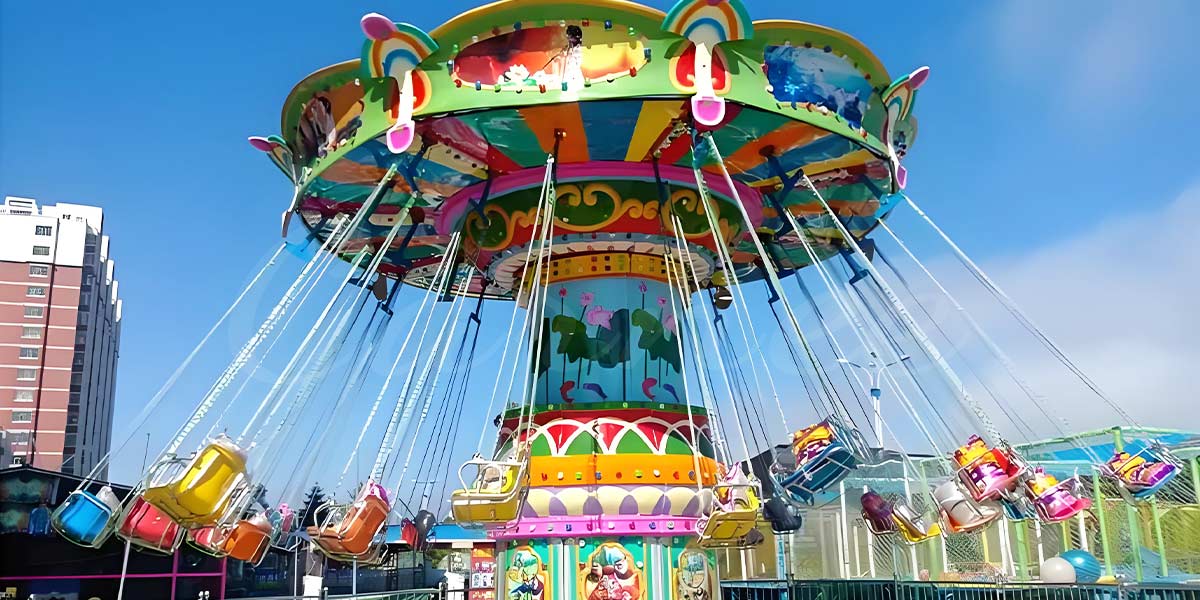
VII. Customization & Future Trends
Can Swing Carnival Rides Be Customized?
Yes. Modern wave swinger amusement rides are highly customizable, allowing park operators to align the attraction with their brand identity, target audience, and overall park theme. Leading manufacturers now provide a wide range of design and functional options, such as:
- Color schemes & decorative themes – Operators can select from vibrant carnival palettes, elegant classical designs, or even minimalist modern aesthetics to match the park’s atmosphere.
- Themed seat designs – Beyond the traditional swing chairs, custom seating may feature animal figures, cartoon IP characters, or branded motifs, making the ride more appealing to children and families.
- Lighting and music integration – RGB LED lighting systems combined with synchronized sound effects transform the flying swing ride into a visually captivating nighttime attraction.
- Customized platforms, fences, and signage – Park-specific branding, safety messages, or thematic decorations can be incorporated into the ride’s supporting structures.
Customization not only enhances the guest experience but also creates a unique selling point for parks in a competitive entertainment market.
Future Trends in Chair Swing Carnival Ride
As the amusement industry continues to evolve, swing amusement park rides are also moving toward innovation and diversification. Key trends include:
- Smart Rides – Integration of IoT technology for real-time performance monitoring, predictive maintenance, and remote diagnostics, ensuring higher reliability and safety.
- Immersive Experiences – Combining VR (Virtual Reality) or AR (Augmented Reality) with traditional swinging motion to provide riders with enhanced interactive storytelling.
- Eco-Friendly Design – Use of energy-efficient motors, LED systems, and sustainable materials to meet growing environmental standards and reduce long-term operational costs.
- IP-Based Attractions – Collaborations with popular movies, cartoons, and cultural icons to create recognizable and marketable rides, making them instant highlights within a theme park swing ride lineup.
These trends demonstrate how the classic carnival rides wave swinger is evolving into a versatile attraction that blends technology, creativity, and sustainability—ensuring its continued popularity in both carnivals and large-scale theme parks.
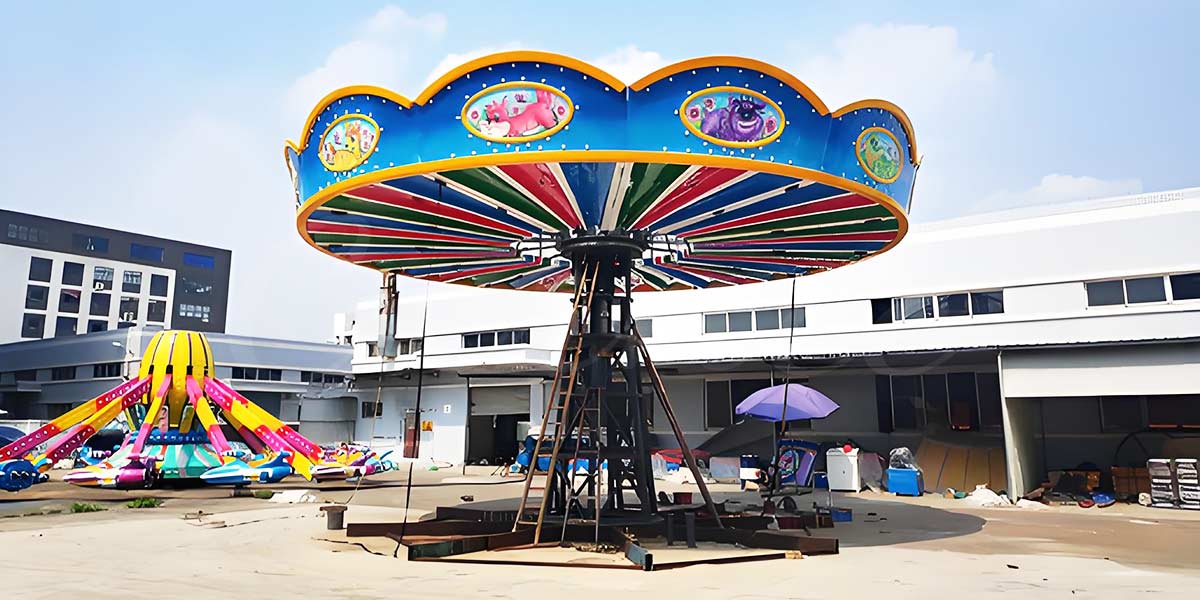
VIII. Quick Swing Carnival Ride FAQ Recap
Conclusion
The Swing Carnival Ride remains one of the most iconic and enjoyable attractions in amusement parks and fairs worldwide. Its timeless design, thrilling motion, and broad appeal make it a valuable addition to any park.
As a leading swing ride manufacturer in China, we offer a wide range of flying chair rides for sale to suit different park sizes and themes. Contact us today to request our product catalog and learn more about exclusive discounts available for new customers.

